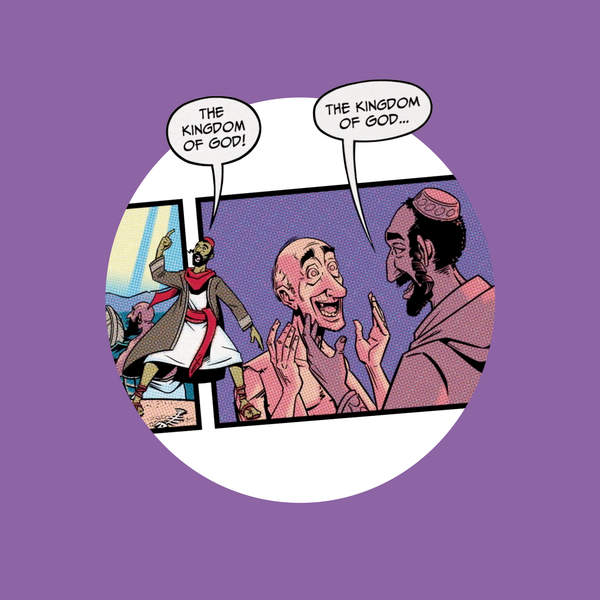
Chaotic Waters and Baptism
Episode Chapters
Show Notes
In part 1 (0- 18:10), Tim and Jon continue to recap key stories in Genesis and the Old Testament. The key themes in these stories are chaotic waters and salvation through them. In Joshua 3, Joshua is getting ready to lead Israel across the Jordan river into the promised land. This story maps onto the story of Israel getting ready to cross the Reed/Red Sea in Exodus as they are fleeing Pharoah. Tim says this story is an example of the “salvation template” being used in Biblical stories. Tim gives another example of Mary’s song that she sings at the birth of Jesus in Luke 1. Tim says this song is a remix of older songs in the Hebrew scriptures. Mary uses the same words, images and phrases used in other parts of the Bible to express her feelings. The guys discuss how these stories allow people to create metaphors and analogies and help people construct a worldview. In part 2 (18:10-25:21) Tim describes the famous passage in Isaiah 11 describing the stump, root, and shoot of Jesse’s descendants. In this part of Isaiah, a “remnant” is being redeemed. Where else in the Bible does a “remnant being redeemed” occur? In the story of Noah and the flood. Noah and his family were the remnant. Tim says Isaiah is using this story in an analogous way to say that God will rescue his scattered nation of Israel from the “chaotic waters” of exile among the nations. In part 3, (25:21-32:34) the guys move to a New Testament story, The Baptism of Jesus in Mark 1. Tim and Jon uncover the similarities in this story and the foundational stories of the Old Testament. Tim asks, "when looking for similarities in biblical stories, what are the controls? What should a person be looking for or be guarded against?" In part 4, (32:34-50:10) the guys move further into the New Testament and discuss Pauline passages in 1 Corinthians 10. Paul describes “our fathers were under the cloud and passed through the sea, and all were baptized into moses in the cloud and in the sea.” What does this mean and why would Paul include it? Tim says Paul is writing to a Gentile audience but views them as being directly related to ancient Jewish fathers. The Corinthians fathers are the fathers of Israel. Therefore the Jewish story of salvation is the Corinthians story as well. Tim shares another example in Romans 6. Here, Paul compares people being “slaves to sin.” Paul borrows language and imagery from the Exodus. Slavery of Israel, Pharoah, death, chaos, and liberation/salvation. Paul also outlines the purpose of Christian Baptism. When a Christian gets baptized, they are reenacting the salvation story, being saved “through the waters” and brought to new life on the other side. Jon ponders why all of this seems so complicated, when he thought salvation should be simple. What does it mean to be “saved from chaos” today? Tim offers that this perhaps means people should be willing to wrestle with the ambiguities and mysteries that these stories present. Everyone has their own slavery, their own salvation story, but the biblical stories provide templates. God conquers chaos and brings order. He sets people up in his image to do the same. In the final part (50:10 -end), Jon asks a question related to the rainbow in the flood story and the future of the world. “Is God going to totally destroy the earth and start fresh? Or will God fundamentally restructure and reorder the earth? In other words, is God not going to flood the earth, or is he not going to let creation collapse back in on itself again?” Tim points Jon to 2 Peter ch. 3 which is the biblical text Jon is thinking of. There are challenges of translation, interpretation, and also a textual variant in the ancient manuscripts of 2 Peter 3. When read closely, the text is clear that God's "fire" is a moral purification that will remove evil from his creation rather than completely destroy the earth itself. 2 Peter is adapting imagery from Zephaniah 3 saying that the evil will not be allowed to pass through the Day of the Lord. In the Old Testament prophets intense, fiery imagery, was not trying to predict future events by giving us “video camera footage”, but instead using provocative imagery to encourage the reader to imagine a purified creation. Thank you to all our supporters! You can learn more about what we’re up to at www.thebibleproject.com
Show Produced By:
Dan Gummel. Jon Collins. Tim Mackie. Matthew Halbert-Howen.
Scripture References
Referenced Resources
- "Metaphors We Live By" by George Lakoff
- "More Than Cool Reason" by George Lakoff
- The Bible Project Video on Design Patterns in the Bible: https://thebibleproject.com/explore/how-to-read-the-bible/
Interested in learning more? Check out Tim's library for a list of recommended books and other resources.
Get the BibleProject app for access to our entire library of resources in one place.